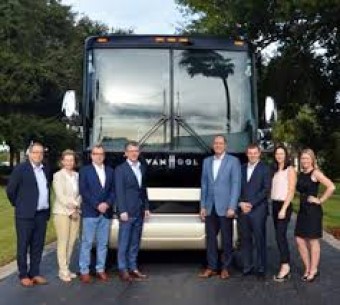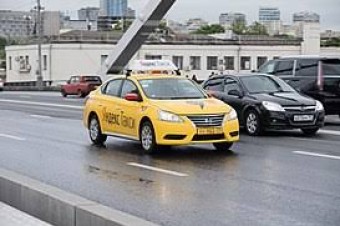Mercedes-Benz Vans invests 50 million US dollars in new joint venture with Via – starts in London.
Mercedes-Benz Vans is entering the ride-sharing sector. To this end, the van division of Daimler AG is setting up a joint venture with the US startup company Via. Daimler Mobility Services additionally joins in as a strategic investor in Via. Unlike other ride-hailing companies, Via has focused on developing, from the ground up, a scalable and on-demand shared ride solution. The intelligent Via algorithm supports smart public transport, enabling a dynamic mass transit system that reduces traffic volume in urban areas. The fusion of Via’s technology with the engineering of Mercedes-Benz Vans creates the perfect match for efficient, affordable and sustainable ride-sharing. As part of the cooperation, Mercedes-Benz Vans is investing 50 million US dollars in the new joint venture. For Daimler Mobility Services, Volker Mornhinweg will be joining Via’s board of directors.
Headquartered in New York, Via’s successful shared ride service in New York, Chicago, and Washington D.C. provides over 1 million rides per month, and its revolutionary technology is licensed by partners around the world. Together, Mercedes-Benz Vans and Via aim to introduce on-demand shared rides in Europe. Via’s revolutionary technology is changing the way people get around cities. With Via’s intelligent shared rides, passengers headed in the same direction are matched with a single van, increasing vehicle utilization while relieving the strain on inner-city roads. London will be the first city to launch the new joint service this year. Other European metropolises will soon follow.
“On-demand ride-sharing offers many new ways of making city traffic efficient, needs-based and sustainable – especially when it involves the use of spacious, safe and comfortable vans,” says Volker Mornhinweg, Head of Mercedes-Benz Vans. “Via is one of the most successful providers in the growing ride-sharing sector while Mercedes-Benz Vans has the perfect vehicles that are being continuously optimised for this job. By deepening our cooperation with Via, we are thus taking the next logical step in the context of our strategy for the future and are expanding our range of new mobility services.” The cooperation is another milestone of the adVANce strategy of Mercedes-Benz Vans focussing on the transformation from a vehicle manufacturer to a provider of holistic van system solutions.
The investment is part of the Daimler strategy focussing on pioneering innovations and digitization, especially in the four future fields of connectivity (Connected), autonomous driving (Autonomous), flexible use and services (Shared & Services) and electric drive systems (Electric). “With our mobility services like car2go, mytaxi and moovel we are already today reaching more than 15 million customers worldwide. As one of the leading providers of digital mobility services our investment in Via is a logical step to expand our portfolio according to our customers’ needs”, says Klaus Entenmann, Chairman of the Board of Management of Daimler Financial Services AG. “We are thus further expanding our digital mobility services. We have the financial resources that are required for this growth path.”
“We are delighted to have the Daimler Group on board as an investor and strategic partner. Combining Via’s technology with the exceptional design and engineering of Mercedes-Benz Vans is ideal for our vision of offering efficient, affordable, sustainable, and comfortable shared rides everywhere,” says Daniel Ramot, co-founder and CEO of Via. “Having completed over 20 million rides, we at Via know that having the right vehicle is crucial for providing the best customer experience. We are excited to expand our successful partnership with Daimler, which began in 2015, and collaborate on developing the optimal vehicle for the future of mobility,” says Oren Shoval, CTO and co-founder of Via.
Via is re-engineering public transit – from a regulated system of rigid routes and schedules to a fully dynamic, on-demand network that provides an innovative supplement to existing transportation networks. Passengers request rides through a mobile app, and Via’s sophisticated algorithm instantly finds a vehicle that best matches the passenger’s route, allowing for quick and efficient shared trips without detours that take riders out of their way.
New joint venture set to establish on-demand shared rides in Europe
Mercedes-Benz Vans and Via have been successfully cooperating since 2015. The joint venture between Mercedes-Benz Vans and Via will operate as a new entity with headquarters in Amsterdam. The joint goal is to bring on-demand shared rides to Europe. The joint venture will not only launch its own service in European cities, but will also license Via’s proprietary technology – the On-Demand Shuttle Operating System – to third parties, such as transport service providers and local public transit operators. By enabling vans to be dynamically routed between thousands of virtual bus stops distributed across the city, this innovative approach to public transit helps reduce traffic volume in cities without requiring the construction of costly new infrastructure.
Long term strategic partnership to further develop the mobility concept
Mercedes-Benz Vans and Via will in the future cooperate on the further development of intelligent mobility, including optimizing the design of Mercedes-Benz Vans vehicles for shared ride use. The models mainly used will be the Vito Tourer (up to nine seats) and the V-Class (up to eight seats) being continuously adapted for this intended use. Beyond developing advanced software and sensors, another focus of the long term strategic partnership lies on the use of the locally emission-free electric-drive Mercedes-Benz Vito and autonomous driving.
- Innovative on-demand shared ride service to launch in Europe: Mercedes-Benz Vans sets up joint venture with US start-up Via.









